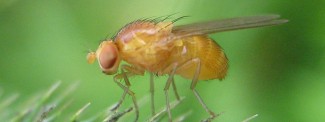Defending oneself against infections is crucial for health and survival. But detecting bacteria before they enter the body is even more advantageous! Our senses of smell and taste are particularly important for survival: they allow us to know if some foods are potentially tainted, poisoned, or expired, thanks to sensory neurons. Are these protection mechanisms also present in animals? This is the question Bassem Hassan, team leader at the Institut du Cerveau – ICM, and his team tried to answer. By studying drosophila, or vinegar flies, the researchers have highlighted that these insects have a TRPA1 receiver, which allows them to detect aversive substances and thus avoid contaminated food. This mechanism is highly conserved between species and is probably essential for survival. The research, performed at the VIB Center for the Biology of Disease and KU Leuven in collaboration with Karel Talavera’s team at KU Leuven, has just been published in eLife.
Our immune system is able to detect and fight infections, but this requires a lot of energy. Humans therefore have mechanisms to avoid them, such as the inflammatory reaction which occurs when a bacterium gets under the skin, or the unpleasant feeling of tainted food. Many organisms, in particular insects, land on and eat rotten food. The Talavera and Hassan teams wanted to know if these animals owned, as humans do, a system to detect the bacteria which develops in this food.
In order to answer this question, the researchers studied a type of vinegar fly named drosophila. Drosophila feeds itself and lays its eggs on rotten food, especially over-ripe fruits which represent a high-energy supply and a source of protein, cholesterol and yeast. However, over-ripe or rotten fruits imply the presence of bacteria, such as Escherichia Coli (E. coli), which releases a toxin that can be as harmful in drosophila as it is in humans.
To study whether drosophila flies have a sensorial mechanism enabling them to detect such bacteria, the researchers offered them two types of food: healthy food and food tainted by the E. coli bacterium. They then observed the flies’ food choices and laying habits. The flies avoided the tainted food that they tasted and quickly rejected, with the females also refusing to lay their eggs on it, which showed that drosophilas have a specific mechanism to detect and avoid potentially dangerous food.
The team then identified the neurons involved in this mechanism as two sensory neurons located in the drosophila’s mandibles, which are able to detect aversive substances. They have also shown that the expression of a sensory receptor, TRPA1, in these cells is essential to this detection. As a matter of fact, when this receptor is removed, the flies eat the food containing the bacterium and the females lay their eggs on it. Without TRPA1, the flies do not differentiate between healthy food and tainted food, showing that this receptor is essential to protect them against infections. This highly conserved mechanism between species is no doubt essential for survival.
Drosophila is not dangerous, but other insects can become a terrible threat to agriculture and represent disease vectors for humans. The aversive substance avoidance mechanism in drosophila is also highly preserved in other insects. The genetic modification of the receptor involved in the detection of harmful substances could make insect pests even more sensitive to bacteria and thus facilitate their elimination in a natural way.







